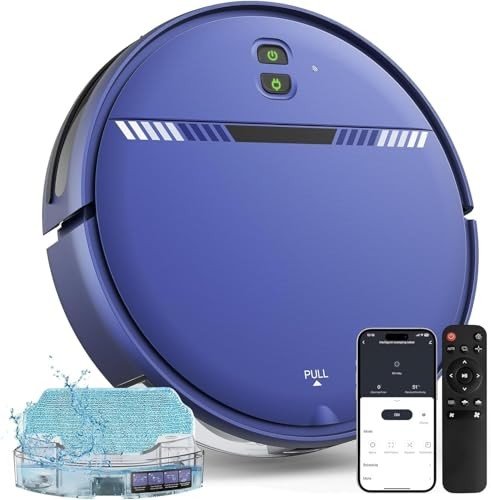Robotic Hoovers: Revolutionizing Home Cleaning
In the busy world we reside in, where time is of the essence, household tasks often take a backseat. Amongst the most considerable developments in domestic technology are robotic hoovers, or robotic vacuum. These intelligent makers have actually transformed the way individuals approach cleaning their homes, enabling performance and benefit that conventional vacuuming can not match. This short article explores the features, advantages, and future of robotic hoovers, along with dealing with typical queries about their performance and upkeep.
What Are Robotic Hoovers?
Robotic hoovers are automated vacuum developed to browse through spaces and clean floorings without human intervention. floor vacuum robot make use of different innovations, consisting of sensing units, cameras, and synthetic intelligence, to find dirt and navigate barriers, making them a valuable addition to modern households.
Secret Features of Robotic Hoovers
Smart Navigation: Most robotic vacuums are geared up with sophisticated sensory technology that enables them to map and navigate areas effectively. This consists of:
- Lidar Sensors: To develop a map of the home.
- Infrared Sensors: To avoid barriers and drops (like stairs).
- Cliff Sensors: Prevents the system from falling off edges.
- Automated Scheduling: Many robotic hoovers can be set to clean up at specific times, maximizing benefit for users.
- Self-Charging: Most designs return to their docking stations when their battery is low, ensuring they are always charged and prepared to tidy.
- App Connectivity: Modern robotic vacuums often include apps that allow users to manage their gadgets remotely, set schedules, and even see cleaning maps.
- Several Cleaning Modes: Options such as spot cleaning, edge cleaning, and arranged cleaning enable personalized cleaning regimens based on the household requires.
Advantages of Robotic Hoovers
- Time-Saving: Robotic hoovers can run individually, maximizing important time for house owners to focus on other tasks.
- Consistency: They supply constant cleaning performance and keep floor cleanliness without the inconsistency that sometimes comes with manual vacuuming.
- Accessibility: With their compact style, robotic hoovers can quickly reach under furniture and into tight spaces where conventional vacuums struggle.
- Upkeep of Various Floor Types: Many robotic vacuum can adapt to various surface areas, including carpets, hardwood, tile, and more.
- Integration with Smart Home Systems: They can be linked to smart home devices, allowing users to incorporate them into their home automation systems.
Comparison of Popular Robotic Hoovers
Here's a quick comparison of some popular designs in the market:
| Model | Smart Navigation | App Connectivity | Battery Life | Price Range |
|---|---|---|---|---|
| iRobot Roomba 675 | Yes | Yes | 90 minutes | ₤ 250 - ₤ 300 |
| Neato Botvac D7 | Yes | Yes | 120 minutes | ₤ 600 - ₤ 700 |
| Eufy RoboVac 11S | Yes | Minimal | 100 minutes | ₤ 200 - ₤ 250 |
| Roborock S6 | Yes | Yes | 150 minutes | ₤ 500 - ₤ 600 |
| Shark ION Robot | Yes | Yes | 120 minutes | ₤ 250 - ₤ 350 |
Upkeep and Care for Robotic Hoovers
In spite of their automated features, robotic hoovers require regular maintenance to guarantee their ideal efficiency. Here are some tips for maintaining a robotic vacuum:
- Empty the Dustbin Frequently: Regular clearing helps keep suction power.
- Clean the Brushes: Hair and particles can block brushes; regular cleaning avoids this.
- Inspect the Filters: Dirty filters can impede efficiency; they should be cleaned or changed as specified by the maker.
- Examine Wheels and Sensors: Ensuring that the wheels are without challenges and sensors are clean will boost navigation and efficiency.
- Update the Firmware: Keeping the robotic vacuum's software application up-to-date can fix bugs and improve performance.
Future of Robotic Hoovers
As technology continues to progress, the capacity for advancements in robotic vacuums is vast. Innovations on the horizon may consist of:
- Improved AI Capabilities: Enhanced learning algorithms may allow robotic hoovers to much better understand homes and cleaning requirements.
- Combination with More Smart Home Devices: Future models may end up being much more incorporated with home automation systems, boosting functionality.
- Advanced Cleaning Features: Innovations like mopping abilities and much deeper carpet cleaning functionality could broaden their utility.
- Sustainability Features: Future models might incorporate environmentally friendly technologies, such as solar charging or recyclable products.
Often Asked Questions (FAQs)
How much do robotic hoovers normally cost?
- Costs for robotic hoovers differ greatly depending on features, however typically variety from ₤ 200 to ₤ 800.
How loud are robotic hoovers?
- A lot of robotic vacuums operate at a noise level in between 50 to 70 decibels, which is quieter than standard vacuums.
Can robotic vacuums handle pet hair?
- Yes, numerous robotic hoovers are developed specifically with powerful suction and brushes to manage pet hair successfully.
Do robotic vacuums deal with carpets?
- Definitely. Most robotic vacuums can clean up various types of surface areas consisting of carpets, wood, and tiles.
Do I require to set my robotic vacuum?
- While you can set schedules and preferences via an app, many designs can also operate on need or immediately once charged.
In conclusion, robotic hoovers represent a remarkable leap in household cleaning innovation, providing exceptional benefit and effectiveness that interest contemporary property owners. As cheap robot vacuum continues to advance, these devices promise even much better cleaning abilities, even more enhancing home health and maintenance. For anyone seeking to simplify their cleaning regimens, buying a robotic hoover can be an immensely fulfilling decision.

